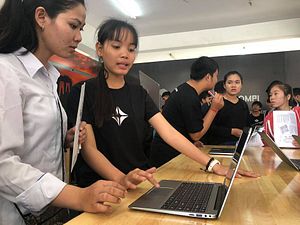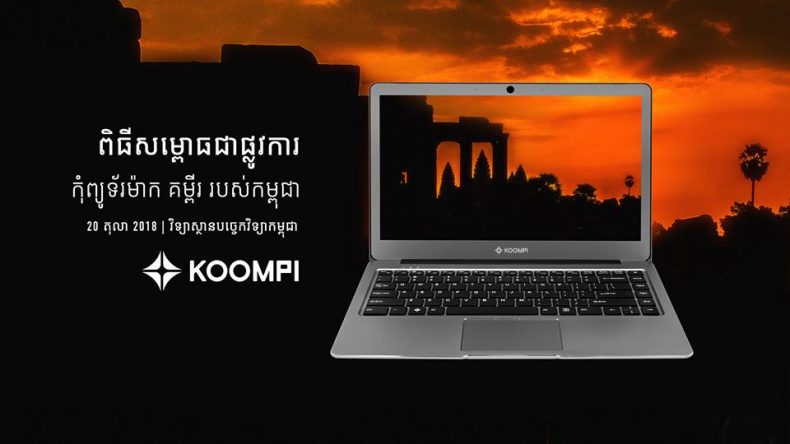October 20 saw the launch of KOOMPI, a Cambodian “home-grown” laptop, at BarCamp ASEAN 2018, the annual regional expo for tech start-ups. The laptop is distinctive for running entirely on Open Source platforms so that production costs are kept low and the device is affordable, and so that owners without a background in computing can “hack” the platforms and become “super-users.” KOOMPI is already doing market testing in Myanmar and exploring bringing the product to other regional markets such as Japan, Brunei, Bangladesh, Indonesia, Laos, and the Philippines.
KOOMPI may be a regional first, but it’s not the only exciting local tech innovation coming out of Cambodia. Just a couple of months previously, Cambodia.AI was launched by regional start-up Slash.co, fostering a community of coders in Cambodia working on Open Source algorithms and pro bono projects. One such project is developing AI capability for the country’s EWS1294 flood detection system, managed by People In Need, to potentially identify “false positive” alarms and predict flood risk too. The timing is apposite: Just last month the World Economic Forum ASEAN summit focused on the “Fourth Industrial Revolution” of the enterprise economy and data-enabled digital technologies such as AI, and its implications for the region.

A close-up of a sensor used in Cambodia’s flood detection system. Photo by Nickie Mariager-Lam/People In Need.
These are exciting developments in a country that for many years has been defined by its humanitarian crises. “‘NGO World’ had taken over the Cambodian brand,” KOOMPI’s co-founder, 31-year-old Rithy Thul, said to me, “but in the last decade the country has moved away from that.”
“For a long time, the narrative around Cambodia was around textile sweatshops and tourism,” Andries De Vos, CEO of Slash.co, told me. “But that’s something the younger generation are changing.”
In fact some of Cambodia’s structural features, which might have been weaknesses in traditional industrial models, might actually be strengths when it comes to adapting to the “Fourth Industrial Revolution.” But what could this mean for the key players that will shape how data, AI and digital technologies are developed, and the values that will shape their global governance?
Workforce Revolution
Perhaps the most obvious structural challenge Cambodia faces is the loss of its middle class in the Khmer Rouge era of the late 1970s. Under Pol Pot’s regime, around a quarter of the population died through starvation, forced labor, and political purges as the Khmer Rouge tried to transform Cambodia into a socialist agrarian economy. Highly-skilled professionals with a formal education, such as doctors and teachers, were especially targeted because they were perceived as threats to the regime’s control of the population.
But the Fourth Industrial Revolution is allowing the country to overturn conventional thinking about its demographic profile. The loss of the traditional elite “means there is less dogma about how things should be done, and fewer entrenched interests,” De Vos observed. “A lot of the historic Cambodian elite lost their status during the Khmer Rouge era, and we are seeing more ‘rags to riches’ stories now – which people here find inspiring and empowering.”
“From a tech perspective, Cambodia is an exciting place to be right now,” said Yohan Brizolier, co-founder of Geeks In Cambodia. “The demographic skew means there is an unusually high proportion of ‘digital natives.’ Cambodia’s youthful and increasingly well-educated population is passionate and energetic when it comes to tech adoption – it feels like every day a new start-up or hackathon or incubator program is put in motion.”
Brizolier’s and De Vos’ observations are borne out by Thul’s own story, and the vision behind KOOMPI. “Many young people in Cambodia have to figure out what they want to do now without role models,” Thul said to me. “I came from the countryside and studied English at university for two years before leaving to pursue self-education instead. I had no background in computer science – my first experience of the internet was in 2005, and my first experience of LINUX was in 2007. KOOMPI is designed to encourage curiosity and learning by doing.”
Much of the debate about the impact of the Fourth Industrial Revolution on the labor market has focused on the way emerging technologies might displace human labor. But they could also enhance and develop a workforce such as Cambodia’s.
“Data-enabled digital technologies such as AI are a huge opportunity for countries like Cambodia, where skilled labor is in short supply, to access expertise being developed elsewhere,” said Dr Ekkehard Ernst, chief of the Macroeconomic Policy Unit at the International Labor Organization.
In Malaysia, Dr. Helmi Zakariah, CEO of the locally-developed AI epidemiologist AIME, described how the technology had leveled out local inequalities in access to specialist skills. “Epidemiology is a specialism within public health in Malaysia that struggles to recruit for a number of reasons,” Zakariah explained. “But when districts have unequal access to expertise for managing resources and developing strategy, this can create regional health inequalities. AIME allows districts that don’t have their own epidemiologists to benefit from sophisticated analysis.”
“These technologies could also potentially allow lower-skilled staff to take on new roles and responsibilities in relation to the technology itself,” Ernst added. A good regional example of this is Sri Lanka’s District Nutrition Monitoring Service (DNMS), a mobile app-based system to monitor child nutrition in the community, which won the 2016 UN World Summit Award for Best App in Health. “We chose to develop an app-based system because it would be easy to learn to use,” Dr. Pamod Amarakoon, who led the development and deployment, told me. “Elderly midwives with limited experience of smartphones were able to get help with the technology from their teenage relatives, who enjoyed sharing their expertise. This technology also allowed the midwives to work in a less bureaucratic, more hands-on way with families, which both appreciated.”
Coding Culture
Another structural challenge Cambodia faces is its size and unique Khmer language. “Cambodia is a small country compared to its neighbors,” Brizolier observed. “The population of Vietnam is around 90 million and Thailand around 70 million, but Cambodia is around 16 million. Additionally, some 65 percent of Cambodians haven’t studied English.”
But these features may be assets when it comes to adapting to the Fourth Industrial Revolution. “Because it’s a small market with a very dynamic young population, you can test your ideas easily and get high impact quite quickly,” De Vos explained. “In some ways it’s preferable to somewhere larger but more stagnant.”
Cambodia.AI’s portfolio of projects includes one designed to celebrate Khmer itself – a Natural Language Processing system that will detect ancient Khmer-language script in Angkor Wat, the temple complex in Siem Reap in north Cambodia, and analyze it. “There are only a few specialists in the world who can read those writings,” De Vos said, “and they’re typically based in affluent countries. So supporting Cambodian software engineers to unlock the country’s heritage using AI allows us to contribute to the culture.”
The country’s distinctive Khmer language has also meant that Open Source – or OS – coding and software, such as the platform KOOMPI is based on, are well-integrated in the country’s technology ecosystem. “I started KhmerOS in 2003 when I came to Cambodia,” Javier Sola, program director at the Open Institute, told me. “There was no software in Khmer then, so the aim was to translate OS software into Khmer. We also developed a set of basic computing tools and software in Khmer itself. Now in Cambodian schools the IT textbooks endorsed by the Ministry of Education refer to this OS software rather than Microsoft, because it’s the only software in Khmer.”
Cambodia’s anchoring in OS also means the country is well-positioned to participate in the global AI network, which has a flourishing OS community at its core. Contemporary AI is characterized by machine learning techniques, where software essentially teaches itself rules and patterns from data. It’s a technology that is ripe for misrepresentation, hype and overselling – but this can be countered through a kind of self-assessment within the coding community. “OS creates a more trustworthy product by allowing the code to be validated, and worked on by a large and vibrant international community of world-class coders,” Dr. Kirstie Whitaker, research fellow at the Alan Turing Institute told me. “Making your code OS also means good developers can see that you’re doing something interesting, and will want to come and work for you.”
This OS culture allows Cambodian start-ups and developers to immediately access the thriving international tech ecosystem on equal footing as tech giants and graduates in advanced economies. “Building a tech company is a war for talent,” De Vos confirmed, “and this has informed our strategy in Cambodia. One of our projects is KhmerML, a highly technical, sophisticated project similar to Google’s AutoML. We wanted to demonstrate what our Cambodian team can do, and we wanted it to be useable by others – so we made it OS.”
This OS culture also positions Cambodia’s tech ecosystem to adapt readily to AI. Sola explained how OS technologies such as KOOMPI, or the software used in Cambodian schools, can be amplified through AI more easily because the technology’s code and the AI code are both OS. “You can go into the code of an OS platform or package, add some AI, and then give it back to the project massively enhanced. The OS world allows us to advance much quicker with tech development and integration.”
Making It New
As a post-conflict nation, emerging from decades of civil war, Cambodia faces limitations on its country-wide infrastructure. But gaps in nascent systems can present a unique opportunity to innovate with digital technologies such as AI.
“It was assumed that economic development required industrial infrastructure,” Zakariah said to me. “But the Fourth Industrial Revolution offers the possibility for any country to simply leapfrog infrastructure development.”
“When a national healthcare infrastructure has not yet been developed, you can use new approaches that are quicker, cheaper, and more efficient than traditional ones,” agreed Dr. Michael Edelstein, consultant research fellow at the Center for Global Health Security at Chatham House. “In the field of vaccination, for example, integrating new technologies at the outset instead of as an add-on to an existing framework has helped countries in low-resource settings to implement public health programs that perform at least as well as some high-income countries.”
There are indications of this appetite for innovation in resource management in Cambodia’s health system. In Phnom Penh, Sihanouk Hospital Center of HOPE was established as an international charity with a creative operating model: the hospital receives international donations of medicine and equipment, and only charges patients for care that draws on resources that the hospital had to purchase; if diagnosis or treatment is undertaken with donated resources, then the patient isn’t charged.

In Sihanouk Hospital, radiologists pose with one of two donated X-ray machines. Photo by M.G. Zimeta.
The emerging infrastructure also means organizations from the private and not-for-profit sector can contribute in innovative ways. “We are investing heavily in helping to train people in Cambodia in AI,” De Vos told me. “As a commercial organization, we have to be proactive and creative about compensating for gaps in local education. It’s not just philanthropy on our part – it’s also our way of finding the best local talent.”
In the information economy, Open Development Cambodia has grown to become an important resource in Cambodia’s civic tech ecosystem, occupying a strategic position that might otherwise be a government responsibility. “In Cambodia there isn’t a central portal or website for data, and we don’t have freedom of information laws,” Try Thy, ODC’s executive director told me. “Open data empowers communities and ensures investors of different sizes have the same information. So we centralize the data from government and civil society and other stakeholders, and make it accessible to anyone. The government also uses our resource because ministries may not automatically share information with each other, but they give their information to us.”
Limitations in data management capacity have also created opportunities for innovation in the technology itself. De Vos told me about an AI Natural Language Processing toolkit being developed by Cambodia.AI to “read” and analyse paper records written in Khmer. “We are running this as a social project because it will unlock a wide range of commercial and social applications, as well as create datasets that can be used as the basis of new AI systems here.”
Data Cultures
A final structural challenge of countries like Cambodia, which could be an advantage for adapting to the Fourth Industrial Revolution, may also the most controversial. Recent rapid developments in AI have been made possible by the advent of “big data,” which is outpacing traditional data governance legislation. In countries such as Cambodia where infrastructure is being established, the relevant legal frameworks for data governance might not yet be in place. In fact, governance culture itself might not yet be established: Earlier this year Cambodia’s national elections were widely criticized by the international community. But “I’ve worked in Europe and Asia, and noticed cultural differences in attitudes to power structures,” De Vos said. “The emphasis in Asia is on economic agency rather than political agency. The government here is economically progressive and conscious of the country’s standing in an increasingly-integrated ASEAN. There are dynasties in Europe too, but much more subtle and more deeply entrenched.”
Some say the lack of legal framework could be an opportunity to pioneer. “We have huge opportunities, and the right tools, to avoid the mistakes of developed economies,” Dr. Divine Ndonbi Banyubala, deputy registrar of Ghana’s Medical and Dental Council, told me. “It is for the local people to examine their values and identity, and decide how to adapt legal and governance frameworks that they might have inherited in a colonial era, but that do not facilitate their development or fit comfortably in their own context.”
Collectivist cultures, such as those that dominate in the Global South, might also be better placed to develop frameworks and legislation suitable for the “big data” age. “There isn’t such an emphasis on privacy here,” De Vos observed, “which means that when it comes to sharing data or trying out a new technology, there is less friction.”
“Our collectivist culture means that many of our activities are directed towards realising communal goals,” Banyubala told me. “If the community understands that data is shared for collective interests, they cooperate. It’s easier to send that message than in a neoliberal, atomistic culture where the message is ‘it’s my data, it’s about me.’”
Thul concurred: “There is strong individualism in the West which means people hold back what they have.” A feature of KOOMPI is its inbuilt learning center, Koursmos, with collectivist values at its core. “Our model is peer-to-peer learning – the whole community shares instead of being dependent on a small group. This model boosts collective knowledge. Users bring school with them anywhere rather than only a few people going to school.”
The Big Questions
The Fourth Industrial Revolution raises significant questions about the governance of data and the technologies that it enables, and the management of resources and national systems for the long-term equitable benefit of a population. These questions have barely been resolved within countries, or about traditional assets and opportunities: they will face additional scrutiny and pressure as unexpected countries demonstrate new strengths.
“The internet era leveled the playing field between countries,” Thul said to me. “Maybe these new technologies will have the same levelling effect. Governments and entrepreneurs in less wealthy countries might need to make a bit more effort, but they already know how to do a lot with less, which is an advantage for their future.”
I put it to Thul that these new technologies brought with them unfamiliar ethical and social challenges. “KOOMPI teaches users to do research and it cultivates an engineering mind-set so that they can solve increasingly harder problems, and create solutions that we can’t imagine yet,” he responded. “This is what we need for the country’s future and for the next generation. It isn’t all the responsibility of government or international organizations.”
Reporting for this piece was supported by the Pulitzer Center on Crisis Reporting.
M.G. Zimeta is an Ethiopian philosopher and writer who has written for The Paris Review, The Atlantic, and Prospect, among others, and broadcast with BBC World Service, BBC Radio 4, and BBC Radio 3. Follow her on Twitter: @mgzimeta


































